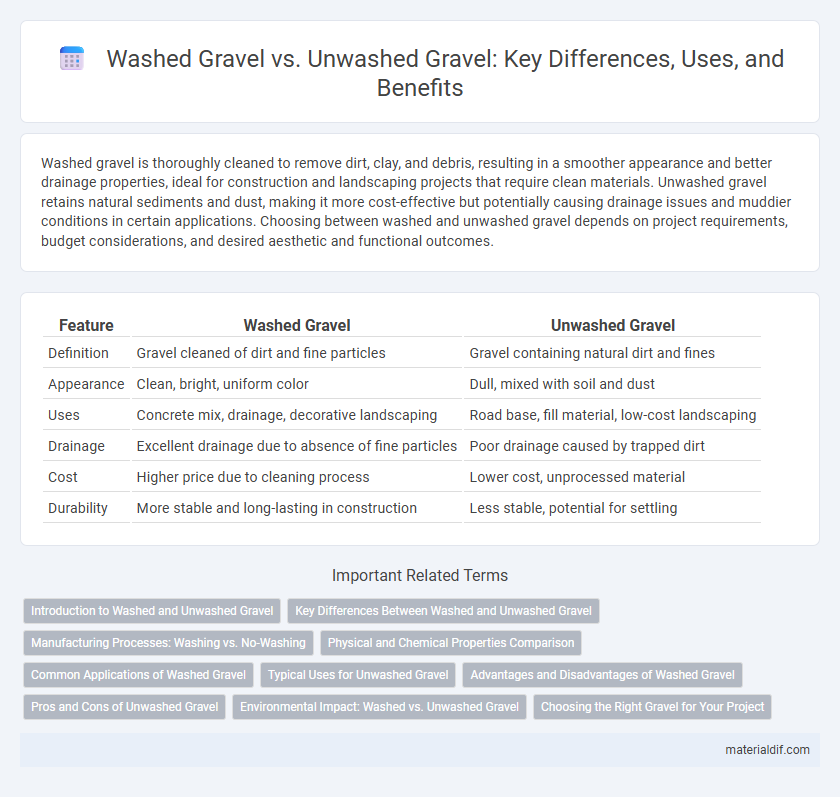Washed gravel is thoroughly cleaned to remove dirt, clay, and debris, resulting in a smoother appearance and better drainage properties, ideal for construction and landscaping projects that require clean materials. Unwashed gravel retains natural sediments and dust, making it more cost-effective but potentially causing drainage issues and muddier conditions in certain applications. Choosing between washed and unwashed gravel depends on project requirements, budget considerations, and desired aesthetic and functional outcomes.
Table of Comparison
| Feature | Washed Gravel | Unwashed Gravel |
|---|---|---|
| Definition | Gravel cleaned of dirt and fine particles | Gravel containing natural dirt and fines |
| Appearance | Clean, bright, uniform color | Dull, mixed with soil and dust |
| Uses | Concrete mix, drainage, decorative landscaping | Road base, fill material, low-cost landscaping |
| Drainage | Excellent drainage due to absence of fine particles | Poor drainage caused by trapped dirt |
| Cost | Higher price due to cleaning process | Lower cost, unprocessed material |
| Durability | More stable and long-lasting in construction | Less stable, potential for settling |
Introduction to Washed and Unwashed Gravel
Washed gravel is cleaned with water to remove dirt, clay, and fine particles, resulting in a cleaner, more aesthetically pleasing material ideal for construction, landscaping, and drainage projects. Unwashed gravel contains natural soil and debris, providing better compaction and stability but less visual appeal. Selecting between washed and unwashed gravel depends on project requirements such as drainage efficiency, surface appearance, and structural performance.
Key Differences Between Washed and Unwashed Gravel
Washed gravel undergoes a cleaning process that removes dust, dirt, and fine particles, resulting in a cleaner, more uniform aggregate ideal for drainage and decorative purposes. Unwashed gravel retains these fines, making it heavier and better suited for construction projects requiring compaction, such as road beds and concrete bases. The key difference lies in the purity and application suitability, with washed gravel offering superior drainage and aesthetics, while unwashed gravel provides structural stability.
Manufacturing Processes: Washing vs. No-Washing
Washed gravel undergoes a thorough cleaning process involving high-pressure water jets to remove dirt, clay, and fine particles, improving its quality and durability for construction purposes. Unwashed gravel skips this step, retaining natural impurities that can affect its strength and increase dust generation on site. The washing process thus ensures a higher-grade product with better compaction and drainage properties, essential for concrete mix and road base applications.
Physical and Chemical Properties Comparison
Washed gravel typically contains fewer impurities such as clay, silt, and dust, resulting in higher permeability and better drainage properties compared to unwashed gravel. Unwashed gravel retains fine particles and organic material, which can affect its chemical stability and may introduce contaminants like salts or minerals that impact pH and reactivity. The physical texture of washed gravel is generally cleaner and smoother, enhancing compaction and strength, while unwashed gravel's rougher surface can reduce structural integrity and increase susceptibility to chemical weathering.
Common Applications of Washed Gravel
Washed gravel, characterized by its clean, debris-free composition, is commonly used in construction projects requiring strong drainage and stable foundations, such as driveways, walkways, and concrete mixes. Its uniform texture enhances water flow, making it ideal for landscaping and erosion control applications. The removal of fine particles prevents clogging, ensuring longevity and improved performance in filtration systems and septic drain fields.
Typical Uses for Unwashed Gravel
Unwashed gravel is commonly used for applications where drainage and stability are essential, such as base layers in driveways, roads, and construction sites. Its natural clay and silt content improve compaction and provide a solid foundation, making it ideal for landscaping projects like pathways and erosion control. Additionally, unwashed gravel is cost-effective for large-scale projects that do not require clean aggregate.
Advantages and Disadvantages of Washed Gravel
Washed gravel offers the advantage of improved drainage and cleaner appearance due to the removal of dust, clay, and debris, making it ideal for landscaping, driveways, and concrete mixes. However, the washing process increases cost and can lead to less soil stability in certain applications compared to unwashed gravel, which retains fine particles that help bind the material. Washed gravel reduces sediment runoff but may require additional compaction or stabilization efforts in construction projects.
Pros and Cons of Unwashed Gravel
Unwashed gravel retains natural dust, clay, and fine particles, enhancing compaction and stability in construction and landscaping projects but potentially causing drainage issues and muddy conditions. It's more cost-effective than washed gravel since it requires less processing and can be ideal for driveways or paths where solid base material is preferred. However, its dirty appearance and increased likelihood of causing grime buildup may make it less suitable for decorative applications.
Environmental Impact: Washed vs. Unwashed Gravel
Washed gravel reduces dust and sediment runoff, minimizing soil erosion and water pollution, making it a more environmentally friendly choice for construction and landscaping. Unwashed gravel contains fines and clay that can clog drainage systems, increase turbidity in nearby water bodies, and harm aquatic ecosystems. Choosing washed gravel supports better water quality management and sustainable land use practices.
Choosing the Right Gravel for Your Project
Washed gravel features cleaned, fine particles removed to ensure better drainage and cleaner appearance, making it ideal for landscaping and concrete mixes. Unwashed gravel retains natural dust and clay, providing a denser base suitable for driveways, paths, and construction projects demanding compact stability. Selecting the appropriate gravel depends on project requirements such as drainage needs, aesthetic preference, and ground compaction strength.
Washed Gravel vs Unwashed Gravel Infographic

 materialdif.com
materialdif.com